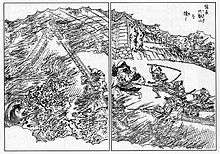Siege of Mount Hiei
| Siege of Mount Hiei | |||||||
|---|---|---|---|---|---|---|---|
| Part of the Sengoku period | |||||||
 Nobunaga forces setting fire to Enryaku-ji and massacring the monks (Depiction in the Ehon taikouki) | |||||||
| |||||||
| Belligerents | |||||||
| forces of Oda Nobunaga | Warrior monks of Mt. Hiei | ||||||
| Commanders and leaders | |||||||
| Oda Nobunaga | Various monk leaders | ||||||
| Strength | |||||||
| 30,000 | Unknown | ||||||
| Casualties and losses | |||||||
| Unknown | 20,000+ civilians plus combatants killed | ||||||
The 1571 Siege of Mount Hiei (比叡山の戦い Hiei-zan no Tatakai) was, according to Stephen Turnbull, so one-sided that it should more rightfully be called a massacre than a siege or battle. Oda Nobunaga led 30,000 men in destroying towns and temples on the mountain and near its base.[1] About 300 buildings were burnt to the ground. This event would mark the end of the great power of Mt. Hiei's warrior monks.
The Tendai monks of Mt. Hiei were long great enemies of Oda Nobunaga, due to their strength and independence, and due to their alliance with the Azai and Asakura clans.
Beginning on September 29, Nobunaga's men attacked the town of Sakamoto at the base of the mountain before moving up towards the Tendai temples. He then destroyed the Hiyoshi shrine honoring the kami of the mountain, Sannō. Nobunaga's massive force encircled the mountain and gradually moved upwards, killing and destroying anyone or anything in their way. Eventually, they made their way to Enryaku-ji, the powerful and famous temple at the summit, which was razed to the ground. His arquebusiers then formed search parties and eliminated anyone who had previously escaped their attack.[2]
George Sansom states, "The whole mountainside was a great slaughterhouse, and the sight was one of unbearable horror."[3]
References
- ↑ Totman, Conrad (1995). Early modern Japan (1. pbk. print. ed.). Berkeley: University of California Press. p. 43. ISBN 978-0-520-20356-3.
- ↑ Turnbull, Stephen (2000). The Samurai Sourcebook. London: Cassell & C0. p. 221. ISBN 1854095234.
- ↑ Sansom, George (1961). A History of Japan 1334–1615. Stanford: Stanford University Press. p. 284. ISBN 0804705259.
Additional Reading
- Turnbull, Stephen (2003). Japanese Warrior Monks AD 949–1603. Oxford: Osprey Publishing.
- Turnbull, Stephen (2005). Japanese Fortified Temples and Monasteries AD 710–1602. Oxford: Osprey Publishing.